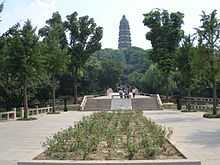Tiger Hill Pagoda


The Tiger Hill Pagoda, more officially the Yunyan Pagoda,[1] (Chinese: 云岩寺塔; pinyin: Yún yán sì tǎ or Chinese: 虎丘塔; pinyin: Hŭ qiū tǎ), also sometimes translated as Huqiu Tower, is a Chinese pagoda situated on Tiger Hill in Suzhou City, Jiangsu Province. It is nicknamed the 'Leaning Tower of China'.[1] It was the pagoda of the former Yunyan Temple. Construction began in 907 AD, during the later period of the Five Dynasties period, at a time when Suzhou was ruled by the Wuyue Kingdom. Construction was completed in 961 AD. The pagoda rises to a height of 47 m (154 ft). The pagoda has seven storeys and is octagonal in cross-section, and was built with a masonry structure designed to imitate wooden-structured pagodas prevalenat at the time. In more than a thousand years the pagoda has gradually slanted due to forces of nature. Now the top and bottom of the tower vary by 2.32 meters. The entire structure weighs some 7,000,000 kilograms (15,000,000 lb), supported by internal brick columns.[2] However, the pagoda leans roughly 3 degrees due to the cracking of two supporting columns.[2]
The pagoda leans because the foundation is originally half rock and the other half is on soil. In 1957, efforts were made to stabilize the pagoda and prevent further leaning. Concrete was also pumped into the soil forming a stronger foundation. During the reinforcement process, a stone casket containing Buddhist scriptures was found. The container had an inscription noting the completion date of the pagoda as the seventeenth day of the twelfth month of the second year of the Jianlong era (961 AD). The uppermost stories of the pagoda were built as an addition during the reign of the Chongzhen Emperor (1628–1644), the last emperor of the Ming Dynasty.[2]
As of September 2010 public access to the top of the tower is no longer allowed.
Notes
References
- Ingles, O.G. "Impressions of a Civil Engineer in China," The Australian Journal of Chinese Affairs (Number 7, 1982): 141–150.
See also
| Wikimedia Commons has media related to Yunyan Pagoda. |
- Leaning tower
- Chinese architecture
- Architecture of the Song Dynasty
| |||||||||||||||||||||||
Coordinates: 31°20′17″N 120°34′35″E / 31.33806°N 120.57639°E